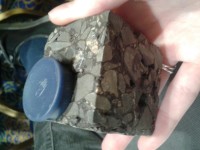
A sample of asphalt to which steel-wool fibres have been added, making the material magnetic.
By Margaret Harris at the AAAS Meeting in Washington, DC
Although Thursday’s LIGO result was extremely exciting, I’m afraid I can only spend so much time pondering ripples in the fabric of space–time before I start yearning for something a little more…concrete. Like, well, concrete. And asphalt. And cement. These decidedly ordinary materials were the stars of two of the most fascinating talks I’ve seen at the AAAS meeting here in Washington DC over the past two days.
First up was Erik Schlangen, a civil engineer at the Delft University of Technology in the Netherlands who develops “self-healing” materials. One of his projects (which you can watch him demonstrate in a TED talk) involves mixing porous asphalt with fibres of steel wool. The resulting conglomerate is magnetic (that’s a magnet sticking to it in the photo), which means that microscopic cracks in it can be repaired using induction heating. The heat melts the bitumen in the asphalt, allowing it to re-fuse, but the surrounding aggregate remains relatively cool – meaning that cars can be driven over asphalt road surfaces almost as soon as the repair is complete.
Another of Schlangen’s projects relates to concrete that has, in effect, been doped with a mixture of bacteria and calcium lactate. When water seeps into a crack in this concrete, the bacteria spring into action: they convert the calcium lactate into calcium carbonate, which blocks up the cracks and makes it harder for the water to penetrate. These busy bacteria can “heal” cracks up to a millimetre in diameter, although Schlangen concedes that it does take them about a month to get the job done.
At the end of the session, I asked Schlangen what was preventing such materials from being adopted more widely. “Money,” he said, bluntly. “Contractors don’t like us – they would prefer to build a road and then come back and repair it again in three years.” However, he added, there have been some positive developments recently in his native Netherlands, where contractors have bid to look after particular roads for 30 or more years – thus giving them an excellent, long-term incentive to cut the cost and frequency of repairs.
That long-term perspective brings us nicely onto another great materials-oriented talk I attended at AAAS. This one was given by Claire Corkhill of the UK’s University of Sheffield, who studies the cement used to seal up the UK’s high-level nuclear waste and prevent radionuclides from leaching into the environment. As it turns out, this cement is a surprisingly complex substance, and its behaviour and structure changes over time – which makes it hard to design cements that can keep radioactive substances locked away for tens (or even hundreds) of thousands of years.
To gain insight into this problem, Corkhill and her colleagues are using the Diamond Light Source synchrotron to measure how the compositions of various nuclear-waste cements change over a period of two years. The hope is that these detailed studies will reveal new ways of containing a particularly nasty radioisotope, technetium-99, which has a half-life of 200,000 years and isn’t stopped by conventional “engineered barriers”.
These studies may not be rocket science (or indeed gravitational-wave physics), but they’re great examples of how physics can help solve real-life problems, and there’s a lot to love about research that straddles the boundaries between physics, chemistry, materials science and engineering. Plus, the enthusiasm of people like Schlangen and Corkhill can be contagious. “I could talk about cement all day,” Corkhill told me, with a grin. Thanks to her and her colleagues, I feel like I could, too.
Guidelines
Show/hide formatting guidelines
this text was deletedwhere people live in harmony with nature and animals</q>
Some text